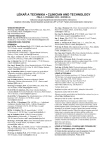MERANIE PARAMETROV ELEKTROMAGNETICKÝCH POLÍ PRI POUŽÍVANÍ PROSTRIEDKOV MOBILNEJ KOMUNIKÁCIE V ŠKOLSKOM PROSTREDÍ
Authors:
Daniela Špigúthová 1; Hana Habinakova 1; Jakub Míšek 1; Viera Jakušová 2; Ján Jakuš 1
Authors‘ workplace:
Ústav lekárskej biofyziky, Jesseniova lekárska fakulta v Martine, Univerzita Komenského
v Bratislave, SR
1; Ústav verejného zdravotníctva, Jesseniova lekárska fakulta v Martine, Univerzita Komenského v Bratislave, SR
2
Published in:
Lékař a technika - Clinician and Technology No. 4, 2015, 45, 122-128
Category:
Original research
Overview
A general increase in the use of modern communication technologies, including mobile communication, had a positive, and a negative impact on the high school environment. The aim of this study was to analyse the level of high-frequency electromagnetic field values in the mobile communication band in the school environment. We conducted measurements of parameters of the electromagnetic fields: the electric field intensity, the magnetic field intensity, the power flux density of the electromagnetic field and the specific absorption rate (SAR) between years 2013-2015 at Grammar School of V. Pauliny-Toth in Martin. The tools used for the measurements were the personal monitor RadMan XT ESM-30 and the broadband high frequency field meter Narda 550. Exposure to electromagnetic fields is subjected to specific safety standards and did not exceeded the allowed limits also during our measurements in unshielded spaces. However we found that electromagnetic radiation from mobile phones increased significantly during phone calls within shielded spaces of the grammar school. Statistical evaluation confirmed the rise of power flux density of electromagnetic field in the school with greather schielding, compared to control unshielded spaces. Safe use of mobile devices at schools is an inevitable part of the protection and health support of the citizen‘s public health.
Keywords:
Electromagnetic field, intensity of electric field, intensity of magnetic field, power flux density of electromagnetic field, SAR, exposure, mobile communication, high school students
Sources
[1] Jakušová ,V., Špigúthová, D., Jakuš, J., Osina, O.: Vedomosti študentov gymnázia a potreba ich edukácie o elektromagnetickom žiarení z mobilných telefónov. 2013. Aktuálne problémy verejného zdravotníctva vo výskume a praxi. Martin: JLF UK, 2013, s. 127-132. ISBN 978-80-89544-39-4.
[2] Tutkun, E. et al.: Ownership And Use Of Mobile Phone – A Population Based Study Physical Education And Sport College Students In Turkey. 2014. Procedia – Social and Behavioral Sciences. 2014, 116: 5215–5222.
[3] Hardell, L., Carlberg, M.: Mobile phone and cordless phone use and the risk for glioma – Analysis of pooled case-control studies in Sweden 1997-2003 and 2007-2009. 2014. Pathophysiology. 2014, 22(1), 1-13.
[4] Stankovic V. et al.: Electric field distribution and SAR in human head from mobile phones. 2015. IEEE (2015): "IEEE 9th International Symposium on Advanced Topics in Electrical Engineering (ATEE), 2015." IEEE. 974 p 392–397. ISBN 978-1-4799-7514-3.
[5] Khullar, S. et al.: Auditory Brainstem Responses and EMFs Generated by Mobile Phones.2013. Indian J Otolaryngol Head Neck Surg. 2013, Dostupné na internete: http://10.1007/s12070-013-0676-0.
[6] Kesari, K. et al.: Biophysical evaluation of radiofrequency electromagnetic field effects on male reproductive pattern. 2013. Cell Biochemistry and Biophysics [online]. 2013, (65)2, 85-96 http://link.springer.com/article/10.1007/s12013-012-9414-6#page-1
[7] Choi, S. et al.: Effects of short-term radiation emitted by WCDMA mobile phones on teenagers and Adults. 2014. BMC Public Healt [online]. 2014, 14:438.
http://www.biomedcentral.com/1471-2458/14/438.
[8] Karanasiou, I. et al.: SAR estimation in human head models related to TETRA, GSM and UMTS exposure using different computational approaches.2014. WSEAS TRANSACTIONS on BIOLOGY and BIOMEDICINE[online]. 2014, (11), 101-11. ISSN 2224-2902. http:/www.wseas.
[9] IARC. International Agency for Research on Cancer. IARC classifies radiofrequency electromagnetic fields as possibly carcinogenic to humans. 2011. [online] Dostupné na internete: www.iarc.fr/en/mediacentre/pr/2011/pdfs/pr208_E.pdf.
[10] WHO. World Health Organization. Mobile phone use: a growing problem of driver distraction. 2012. [online] Dostupné na internete:
[11] ICNIRP. International Commission on Non-Ionizing Radiation Protection. Guidelines for Limiting Exposure to Time-Varying Electric,Magnetic and Electromagnetic Fields (up to 300 GHz). 1998. Health Physics. 1998; 74 (4): 494-522.
[12] Vyhláška Ministerstva zdravotníctva Slovenskej republiky č. 534/2007 Z. z o podrobnostiach a požiadavkách na zdroje elektromagnetického žiarenia a na limity expozície obyvateľov elektromagnetickému žiareniu v životnom prostredí..
[13] CENELEC: Expozícia EMP v pásme vysokých kmitočtov (10 kHz – 300 GH). 1995. Bruxelles, CENELEC, 1995,44 s.
[14] Gherardini, L. et al.: Searching for the perfect wave: the effect of radiofrequency electromagnetic fields on cells. 2014. International journal of molecular sciences. 2014, 15.4: 5366-5387.
[15] Ikeda, K., Nakamura, K.: Association between mobile phone use and depressed mood in Japanese adolescents: a cross-sectional study. 2014. Enviromental health and preventive medicine. 2014, 19(3): 187–193.
[16] Redmayne, M., Smith, E., Abramson, M.: The relathionship between adolescents well-being and their wireless phone use: a cross-sectional study. 2013. Enviromental Health. 2013, doi: 10.1186/1476-069X-12-90. Environment, 2014, ISBN 978-972-8822-28-6.
[17] Chiu, C., T. et al.: Mobile phone use and health symptoms in Children.2015. J Formos Med Assoc. 2015, 114(7): 598–604.
[18] Zheng, F. et al.: Association between mobile phone use and self-reported well-being in children: a questionnaire-based cross-sectional study in Chongqing, China.2015. BMJ Open. 2015, doi:10.1136/bmjopen-2014-007302.
[19] Moriwaki, A., Kamio, Y.: Normative data and psychometric properties of the strengths and difficulties questionnaire among Japanese school-aged children. 2014. Child Adolesc Psychiatri Ment Health [online]. 2014, 8:1. Dostupné na internete: http://www.ncbi.nlm.nih.gov/pmc/articles/PMC3903008/.
[20] Osina, O., Vasíčko, T., Habiňáková, H., Špigúthová, D., Osinová, D., Jakušová, V., Jakuš, J.: The environmental exposure of young people to electromagnetic fields – personal exposimetric evaluation. 2014. EHE 2014: International Conference of Electromagnetic Fields, Health and Environment, 2014, ISBN 978-972-8822-28-6.
Labels
BiomedicineArticle was published in
The Clinician and Technology Journal

2015 Issue 4
Most read in this issue
- MERANIE PARAMETROV ELEKTROMAGNETICKÝCH POLÍ PRI POUŽÍVANÍ PROSTRIEDKOV MOBILNEJ KOMUNIKÁCIE V ŠKOLSKOM PROSTREDÍ
- Spectral analysis of atrial components of ablation catheter signals during slow pathway ablation for typical atrioventricular nodal reentrant tachycardia
- Multi-electrode microfluidic platform for protein detection using electrochemical impedance spectroscopy
- Effect of linear accelerator settings on evaluation of dosimetric verification of VMAT plans
